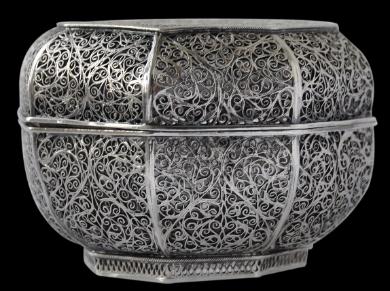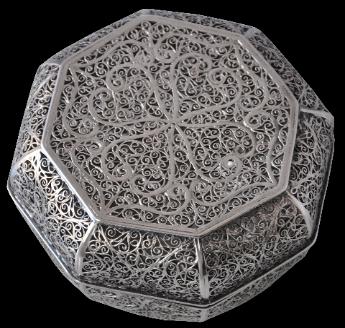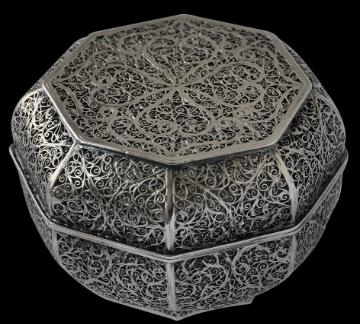
Batavian-Chinese Silver Filigree
Melon-shaped Silver Filigree Covered Box
China, India or Batavia, Dutch East Indies
17th-18th century
diameter: 8.5cm, height: 6.5cm, weight: 180g
This very pleasing eight-sided covered box is made entirely of solid silver filigree with a combination of broader, flattened wires and thinner, twisted wires. The box comprises two equal halves with rounded edges. It sits on a low octagonal foot.
The form appears to be based on pumpkin-shaped cinnabar lacquer boxes that were produced in China during the period.
The combination of wide, flattened wire components with fine twisted filigree work is found on articles often ascribed to Goa of the second half of the seventeenth century – see Menshikova (2006, p. 43) for two examples, and Levenson (2007, p. 263-4) for others. Menshikova refers to filigree items of this type as having been made by ‘Chinese masters in India or Southeast Asia’ in the seventeenth century, which leaves open the possibility that such items might have been made in Batavia perhaps, and most probably traded by the Dutch East India Company (VOC). Most such work however is ascribed to Goa.
The box is in fine condition. The contours have been softened and rounded from years of handling. There are no apparent losses to the filigree.
References
Curvelo, A.,
et al, The Orient Museum, Lisbon, Reunion des Musees Nationaux, 2008.
Jordan, A.
et al, The Heritage of Rauluchantim, Museu de Sao Roque, 1996.
Levenson. J. (ed),
Encompassing the Globe: Portugal and the World in the 16th and 17th Centuries, Arthur M. Sackler Gallery, 2007.
Menshikova, M.,
Silver – Wonders from the East: Filigree of the Tsars, Hermitage Amsterdam, 2006.
Museo de Sao Roque,
The Heritage of Rauluchantim, 2006.
Provenance
UK art market
Inventory no.: 1846
SOLD




